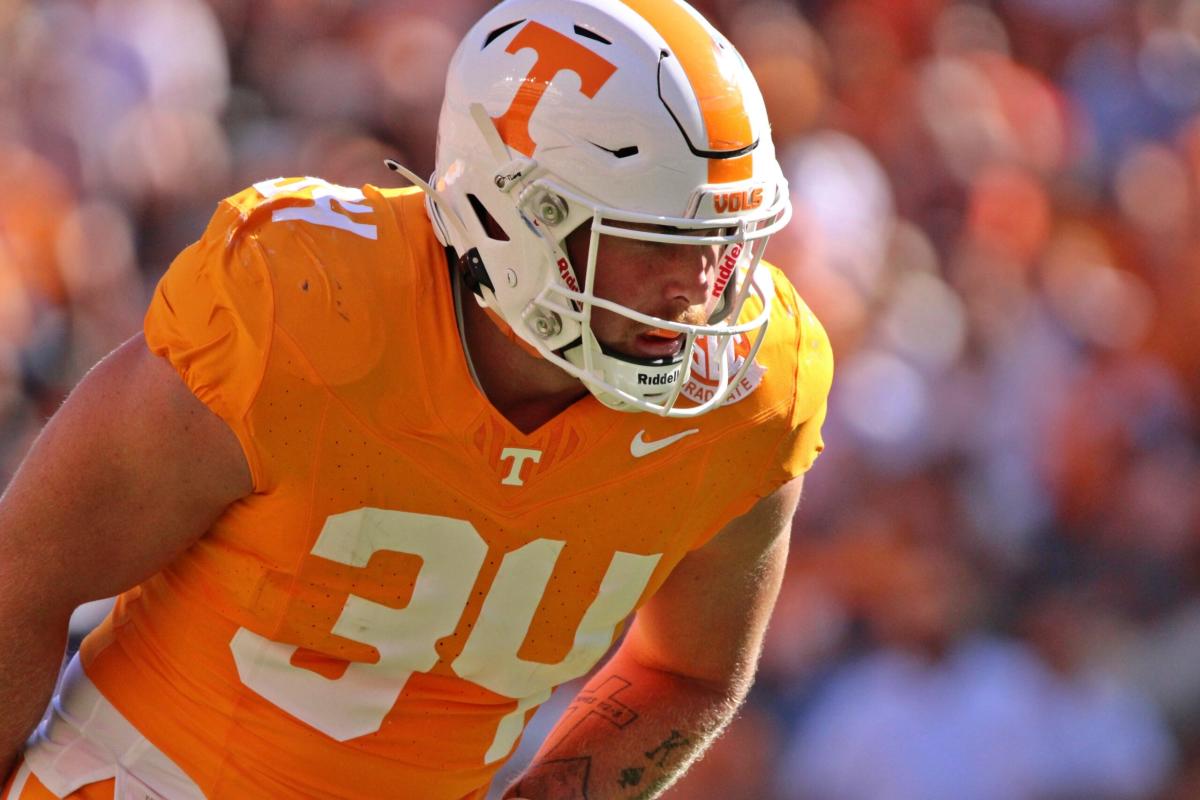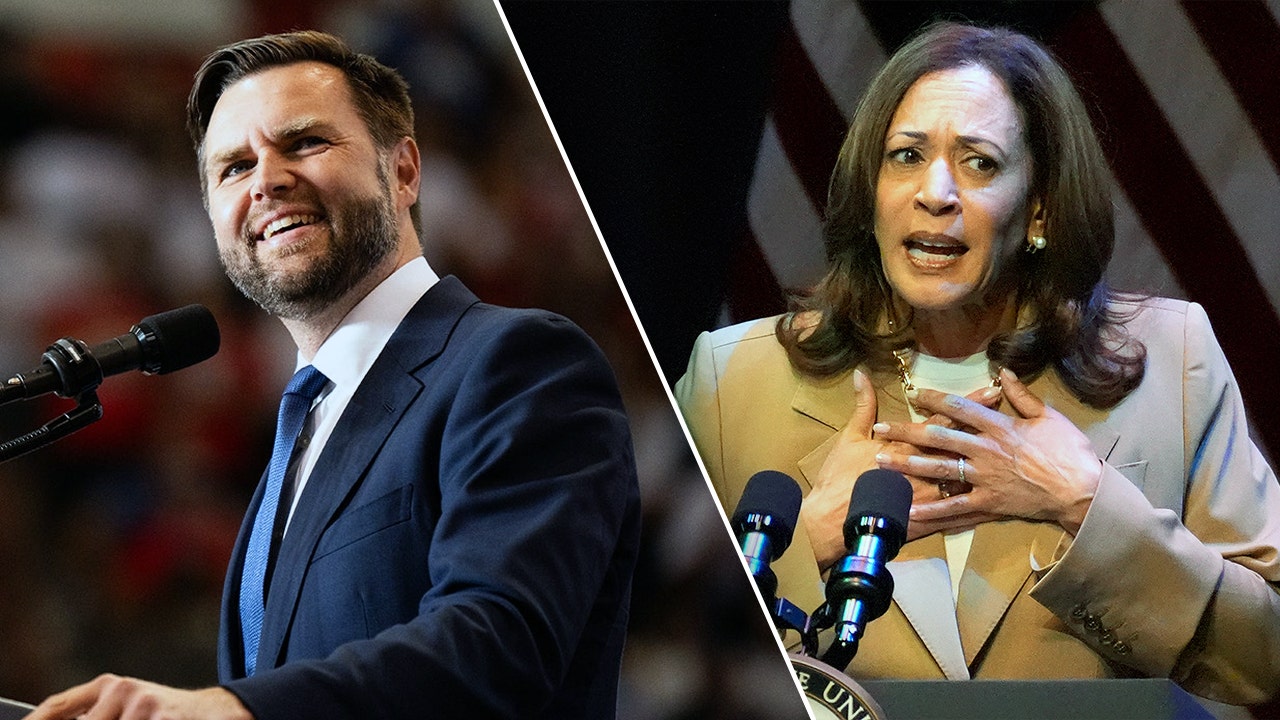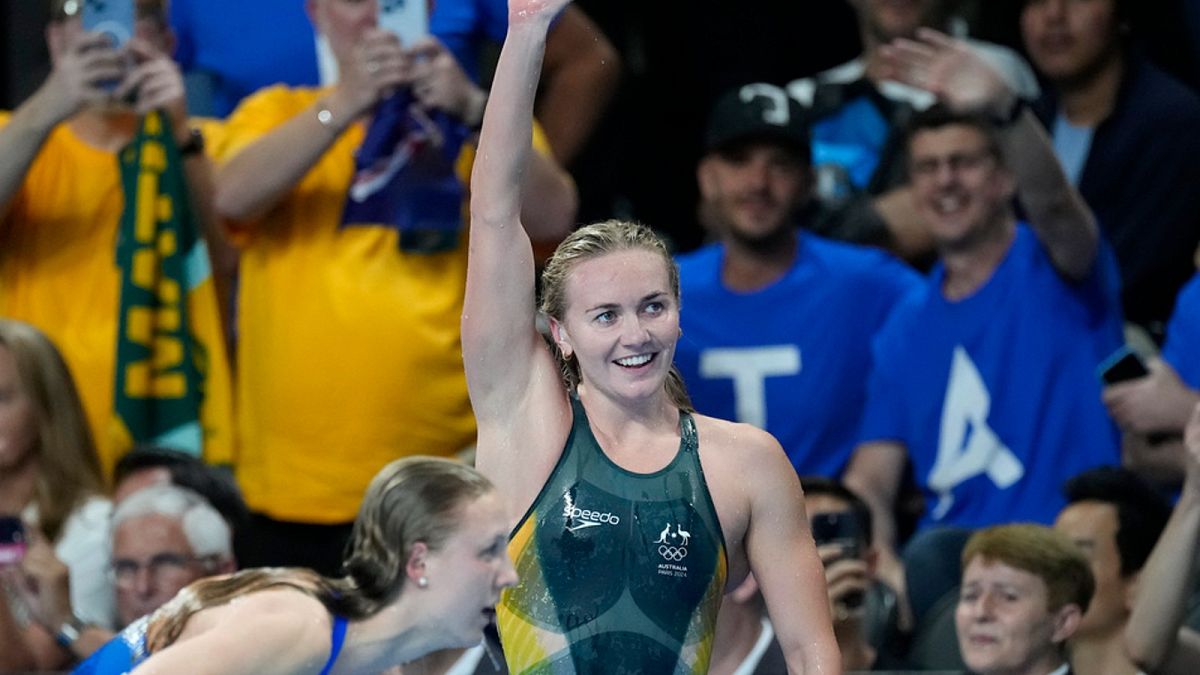Sports
Rafael Nadal dismisses suggestions Olympic match with Novak Djokovic will be tennis duo's 'last dance'
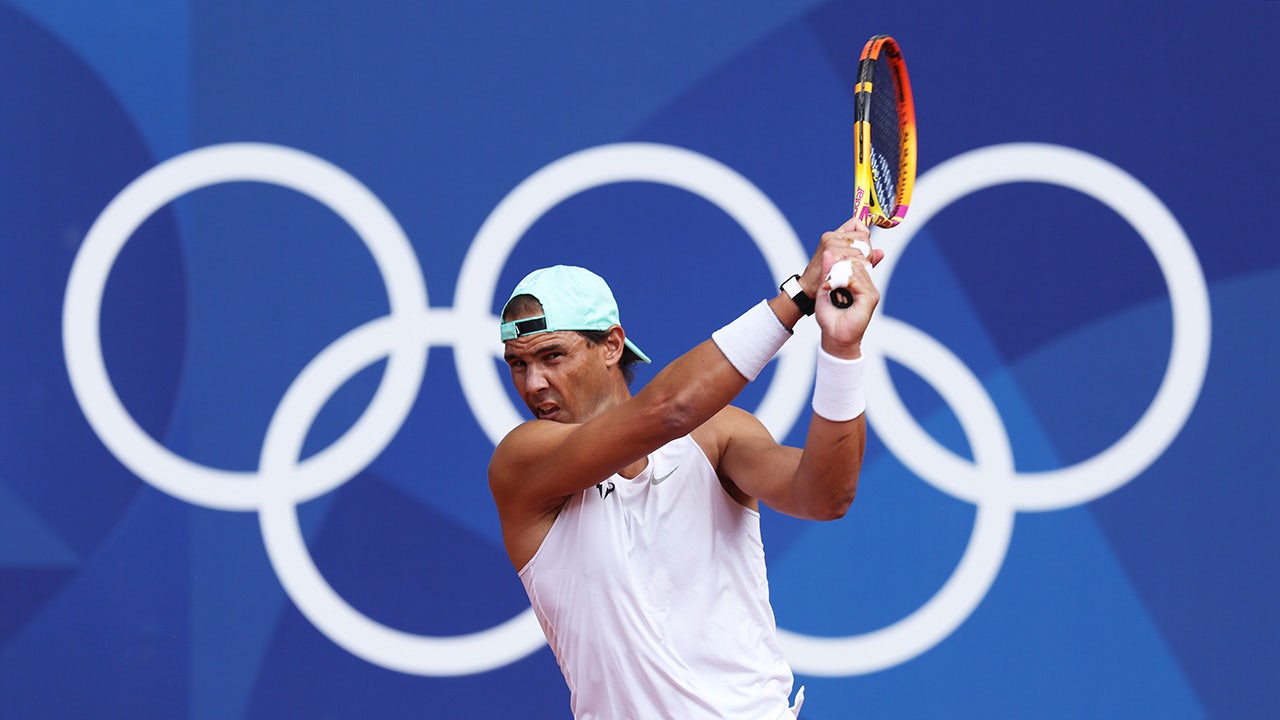
Spanish tennis star Rafael Nadal celebrated his 38th birthday last month.
The 22-time Grand Slam singles winner has had some injury setbacks in recent years, which fueled the belief he would soon step away from the sport he has dominated for so long.
But Nadal did his best to dispel any notion the 2024 Paris Olympics would mark the final chapter of his storied career.
Shortly after the opening round of men’s doubles matches at Roland Garros, where he has won the French Open 14 times, Nadal hinted his longtime rivalry with Novak Djokovic is nowhere near its ending.
Rafael Nadal of Team Spain plays a backhand during a training session ahead of the Paris 2024 Olympic Games at Roland Garros July 24, 2024, in Paris. (Clive Brunskill/Getty Images)
“Who say that’s last dance?” Nadal quipped when asked if he was prepared for a possible “last dance” with Djokovic in singles competition during the Summer Games.
Nadal is scheduled to face Hungary’s Marton Fucsovics in the opening round of men’s singles Sunday. The Spaniard previously seemed uncertain if he would compete against Fucsovics, saying, “I don’t know if I’m going to play or not,” according to The Associated Press.
ANDY MURRAY ANNOUNCES PLANS TO RETIRE AFTER 2024 PARIS OLYMPICS
Nadal noted that he wanted to discuss his plans for Sunday’s competition after he finished playing on Saturday “and then make the smartest decision possible to have the best chances to bring [a] medal back home.”

Rafael Nadal of Spain carries the Olympic torch during the opening ceremony of the Paris 2024 Olympics July 26, 2024. (Stephanie Lecocq/Pool/AFP via Getty Images)
If Nadal defeats Fucsovics, he would earn a spot in the second round, which is where he would likely face Djokovic.
The Serbian and all-time major singles title record holder expressed excitement about the opportunity to compete against Nadal — especially if it would indeed be for a final time.
2024 SUMMER OLYMPICS: LIVE UPDATES
“If we get to face each other, it’s going to be possibly the last time we’re going to face each other on a big stage,” Djokovic said. “So, I’m sure that people would enjoy it. I’m looking forward to it, and I’ll be ready for that matchup.”
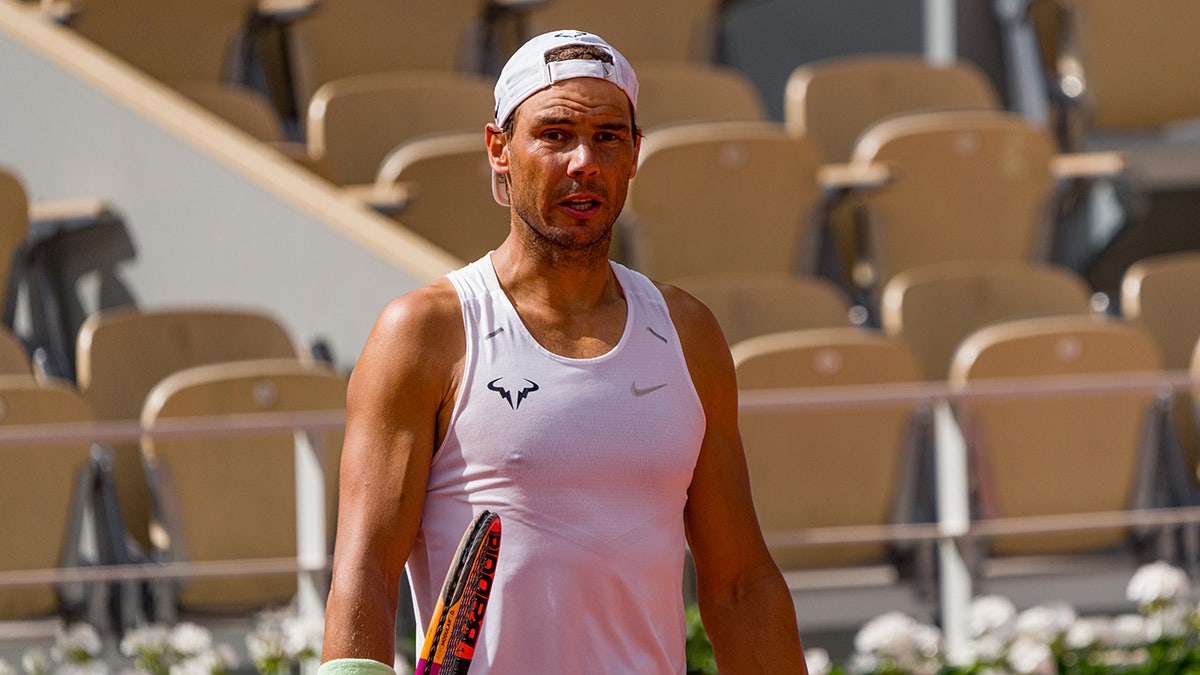
Rafael Nadal of Team Spain during a training session at Roland Garros ahead of the Paris Olympic Games July 23, 2024, in Paris. (Andy Cheung/Getty Images)
Nadal and Djokovic have not gone head-to-head since the quarterfinal at the French Open in 2022. Nadal outlasted Djokovic in that meeting. He went on to win his 14th title at Roland Garros.
“Playing him is like finals, in any tournament,” Djokovic said. “Particularly here, knowing what he has achieved and what he’s done for our sport, but particularly here at Roland Garros, his record speaks for itself.”
Nadal said playing in Saturday’s doubles match with Carlos Alcaraz was “emotional.”
“[It was] an emotional night, an electrifying night, amazing crowd,” Nadal said. “To play with Carlos on this court has been so special. I’m just super happy about the victory. It gives us a chance to keep going.”
While the “King of Clay” will eventually end his superb career, the Olympics may not be his final bow.
Follow Fox News Digital’s sports coverage on X, and subscribe to the Fox News Sports Huddle newsletter.

Sports
Can American men's gymnastics team give a waning U.S. sport a boost in Paris?

Follow our Olympics coverage from the Paris Games.
When John Roethlisberger was an undergraduate at the University of Minnesota, he and his gymnastics teammates vanned to meets at Iowa, at Iowa State, at UW Oshkosh and Wisconsin. Every year, they’d fly to Michigan, where they’d compete against the Wolverines on a Friday night and head to Michigan State on a Sunday.
Of those teams, only Michigan continues to sponsor the sport today. This is not breaking news. The decline of men’s gymnastics has been both ongoing and relentless, a death-by-a-thousand-paper-cuts slashing that has pushed it to near extinction. Only 12 Division-I universities now sponsor men’s teams, none do at the D2 level and just three in D3. All of 319 men competed in NCAA gymnastics this past season.
The danger of real elimination, though, has never been more real than it is now. With payouts to athletes about to come due from a recent House settlement, athletic departments are looking to pinch pennies. Sport elimination remains a real threat and, with so few viable teams and athletes already, men’s gymnastics is ripe for the picking.
Yet the college system still serves as the direct feeder for international competition. In Paris, the United States is fielding its strongest men’s Olympics team in decades, with legitimate aspirations to make a team podium for the first time in 16 years. All five men headed to Paris come via the college route — Asher Hong and Frederick Richard remain in college, at Stanford and Michigan, respectively. Paul Juda wrapped up his eligibility with the Wolverines this year and Brody Malone with the Cardinal a year ago. Pommel horse specialist Stephen Nedoroscik lost his senior season at Penn State to COVID-19.
USA Gymnastics desperately needs the college system. But can the USA gymnasts, with a successful run at Paris, help save college gymnastics?
“This team could do a lot. They are the tip of the spear,” says Roethlisberger, a three-time Olympian who remains outraged at his alma mater’s decision to eliminate gymnastics in 2020. “We have athletes who can absolutely win medals, but will they be the darlings of these Olympics? Probably not.
“We are on the precipice of catastrophic change in college sports. So who is going to stand up and say, ‘I’m going to show the world how this can actually work?’ Our athletes can do a lot, but they can’t do it alone.”
Thom Glielmi used to scam money off his pals, taking $10 bets that he couldn’t flip off whatever he could find — the roof of a garage, for example. He did it largely for the thrill, but then he spied the gymnastics equipment at Lincoln-Way Central High School in Illinois and realized he could put his flipping to good use. He ditched baseball, signed up for gymnastics and found himself a life. A former gymnast at Southern Illinois, Glielmi is now in Year 22 at Stanford, where this year he led the Cardinal to its seventh national championship.
“If my high school didn’t have gymnastics, I’m not sure what would have become of me,” Glielmi says.
It’s the same question he asks when he hits the recruiting trail now: What’s to become of the boys who want to compete? In 1982, around the time Glielmi was flipping his way through Lincoln-Way, more than 75 colleges and universities sponsored men’s gymnastics, and in 1984 one of them — UCLA — supplied three members of the United States team that captured Olympic gold. A decade later, the Bruins program was eliminated. By 2002, only 21 teams remained at the collegiate level.
The initial culprit — or at least the easy blame — was Title IX. Forget that Title IX didn’t make a whole lot of sense as a counterargument — gymnastics, unlike, say, football, offers a women’s equivalent — but athletic directors, looking for easy fixes to federal equivalency regulations, slashed the sport in big numbers in the late ’80s and early ’90s.
COVID brought another wave, and now men’s gymnastics has fewer NCAA teams than water polo.
“So many guys, I just feel terrible for them,” Glielmi says. “The competition is so high, and there’s just nowhere for some of these athletes to go.”
American star Fred Richard celebrates after his horizontal bar routine Saturday during the Olympic qualification round. (Loic Venance / AFP via Getty Images)
No surprise, then, that as the college opportunities dry up, so too does the interest. Men’s gymnastics always has fought an uphill battle. Roethlisberger came to his sport naturally. His father, Fred, was a 1968 Olympian and spent three decades as the head coach at Minnesota; his big sister, Marie, was a 1984 Olympian. He also knows he is the exception. Roethlisberger speaks regularly at awards dinners and camps and often opens with a favorite joke. He describes the giddy joy of a delivery room, where a newly proud papa grabs his infant son and declares, “I finally got my gymnast!” He laughs at his gallows humor.
“It’s the truth,” he says. “Those are the norms of our society. Most little girls try gymnastics at some point. They dream about bows in their hair and sparkles on their leotards. Little boys dream about playing football, baseball or basketball.”
There are, in truth, plenty of ancillary things at play here. Societal norms indeed feed popularity. “You can see more cornhole on TV now than men’s gymnastics,” Roethlisberger says. Even physiology has a role. “You have to be strong (to do this sport),” says Gina Pongetti, a physical therapist and owner of MedGym, who has worked in gymnastics for more than 20 years, “and many of them aren’t right away, so they get frustrated and quit.”
But largely it is the intersection of opportunity and cash. Roethlisberger has a summer camp, Flipfest, in Tennessee that attracts 400 kids on average per week. Fifteen percent of them are boys, a minority but still a solid number. The Tennessee Secondary School Association does not sponsor boys gymnastics, and, according to the most recent National Federation of High Schools participation report, not a single of its member high schools in Tennessee offers it.
In fact, only 100 do nationwide, with just 986 high school-aged boys competing. So, are colleges no longer funding gymnastics because there are no gymnasts to fund, or are there fewer gymnasts because there’s nowhere to go? Most people associated with the sport believe it’s the latter. Gymnastics is not cheap. A conservative estimate for competitive gymnastics runs $500 per month.
Yet the return on that investment is opportunity at just 15 schools — and only 6.3 scholarships available at each school.
“There’s an understandable quid pro quo,” Pongetti says. “The dollars and the time put into the gym, that turns into the college scholarship opportunity, but what if there’s no college scholarship or even opportunity to compete?”
Roethlisberger is in the thick of it. He has three boys. They’re enrolled in gymnastics, not just because their dad loves it but because he truly believes that its combination of strength and balance offers the best foundation for any sport. But he also knows that there could be a tipping point.
“They can love it all day long,” he says. “But then you start to look around and say, ‘Well, there’s nowhere to go. How about we try baseball or lacrosse?’”
Glielmi considers the number being tossed around as the likely sum necessary to fund athletes’ payments post-House settlement — $22 million. “That’s 22 gymnastics teams,” he says with a sigh. He’s not wrong. Men’s gymnastics is not a departmental money maker, which makes it an easy sport to slash. A glance at the NCAA reports filed by Penn State, Ohio State, Illinois and Oklahoma show deficits ranging from $600,000 to $1.9 million. It also, however, does not cost much, especially at places that have viable women’s programs and available practice gyms. The expenses at those same schools average around $1.3 million.
But the dearth of teams offering the sport combined with the need to shave spending puts men’s gymnastics in a vulnerable position.
“The less programs that stay, the easier it is to follow suit and chop,” says Pongetti. “It’s a dangerous, dangerous, domino effect.”
By and large, athletic directors have not been historically creative when faced with similar crises. Minnesota cut its men’s team in 2020 — per the NCAA report, it saved the school $748,167 in expenses. Administrators stood their ground even after the alumni rallied to offer to fund everything except coaching salaries and gym space. Instead, the alums, along with head coach Mike Burns, funded a club sport that this year included a roster of 25 that went on to win the club national title. Since 2021, the school provided gym space rent-free but in May announced it was reappropriating Cooke Hall to use for the diving team. The gymnasts have nowhere to go.
“This is the Titanic attempting to turn around in the Suez Canal,” Roethlisberger says. “Athletes are going to get paid from the school, so what are we going to do about it? There are ways. Engage the alumni. Huddle up. But what athletic director is going to stand up and say, ‘Here’s the new model?’ Who is going to be bold enough to do that?”
That it falls largely to the colleges is part of the problem. In many other countries, sports are government-funded. Here, many of the national governing bodies offer little if anything in the way of financial support, and rely instead on the college system as the feeder program. Fourteen U.S. teams headed to Paris, including men’s gymnastics, are made up entirely of NCAA athletes. More than 100 members of the track and field contingent come from the NCAA ranks, and 44 for swimming.

Minnesota’s program carries on with alumni support. Shane Wiskus, here at the 2021 NCAA championships, was a Tokyo Olympian. (Carlos Gonzalez / NCAA Photos via Getty Images)
But there is no real reciprocity between the NCAA and the NGBs. A think tank commissioned by the U.S. Olympic and Paralympic Committee post-pandemic suggested such a partnership, and the two groups have discussed aligning forces. Nothing concrete yet has come out of it.
Men’s gymnastics is not entirely blameless. NCAA women’s gymnastics is growing. NIL opportunities have made staying in college more appealing to Olympic gymnasts — Team USA members Sunisa Lee, Jade Carey and Jordan Chiles all went to college — and their participation has helped raise the sport’s profile. The ACC and SEC Networks regularly broadcast meets and ABC aired the NCAA championship. The decision to stick to the more familiar scoring system — a 10 is perfect — has helped keep viewers engaged, as well as entertained. The men, on the other hand, use the open-scoring system, where a combination of difficulty and execution results in a final score.
There is ample evidence of interest. Richard has 670,000 TikTok followers and 310,000 more on Instagram. More than 50,000 follow Malone’s Insta account.
“We hear all the time that there’s a great product here,” Glielmi says. “We just haven’t put it together. If we can manage all of that and stay true to the sport, make it easier to understand, we’ve got a better chance of people sticking around.”
Which is where this men’s team comes in.
Americans love nothing more than winning, and the lack of medals has hurt men’s relevance. This team has the stuff to change that. After the Tokyo Olympics, the United States made a concerted effort to up the difficulty in its routines. At the 2020 Games, the U.S. started a full 6.5 points behind its competition because its sets weren’t properly stacked. Now they stand just two points behind Japan and 3.6 behind China, well within striking distance of the podium.
In Saturday’s qualification round, the U.S. qualified fifth for the team all-around. The final is Monday.
Along with his social media following, Richard brings legit hardware to Paris. He is only the fourth American man to medal in the all-around at the world championships — he won a bronze — and the first in a decade to medal in more than two world events. Malone, an Olympian in 2020, is back after a gruesome leg injury. He has a good shot at medaling on the high bar. Pommel horse specialist Nedoroscik is the 2021 world champion in that event.
Maybe more than anything, they understand their mission.
“That is my passion, and that is all of our responsibility — growing the sport,” says Richard. “All of the medals, the success, that’s what this is about. We grew up giving everything to gymnastics, and we want kids growing up to have way more colleges to select from, to be blessed with what they deserve.”

GO DEEPER
Fred Richard, after lifetime of handstands, is built to burst onto Olympics scene
(Top photo of gymnast Paul Juda during U.S. Olympic trials: Elsa / Getty Images)
Sports
From the NBA to the beach: Chase Budinger is eager to 'shock the world' on Olympic stage
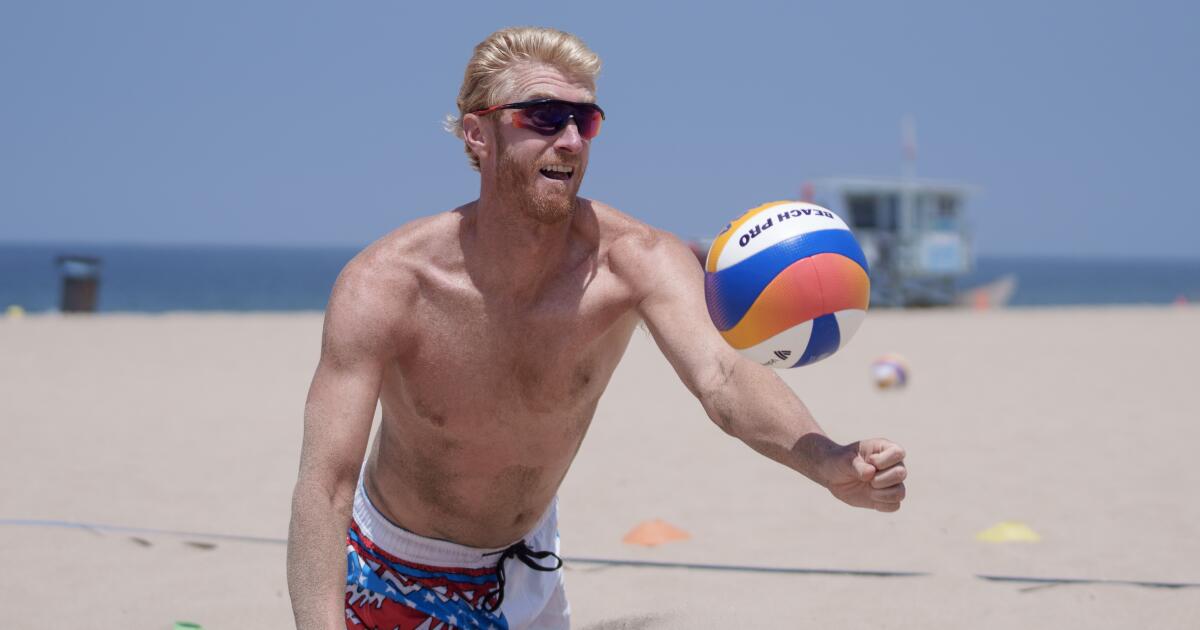
Although Chase Budinger is exhausted from a two-hour practice, he accepts warmly when a young fan approaches for a photo on the boardwalk near the Hermosa Beach volleyball courts. The boy had watched the final hour of Budinger’s practice with partner Miles Evans from a nearby patio and waited for the perfect moment to take a photo with one of the top beach volleyball players in the world.
Craning his neck to look up at the 6-foot-7 Budinger, the boy thanks him for the snapshot.
“And you played in the NBA too, right?” he asks.
Budinger smiles in the affirmative. Sometimes he even forgets about his first career.
2024 Paris Summer Olympic Games
To most of the United States, he’s more often recognized as the former Arizona basketball star who was picked in the second round of the 2009 NBA draft, an NBA journeyman who once jumped over a rap star during a dunk contest or the co-most valuable player at the 2006 McDonald’s All-American game who shared top billing with Kevin Durant.
A career change later, call him something new: an Olympian.
The forward-turned-blocker will make his Olympic debut with Evans in Paris on Monday in the first match of pool play. The pair of Olympic rookies are an unlikely duo. The NBA player. The 6-foot-4 defender who didn’t start playing volleyball until sophomore year of high school. They’re “underdogs,” said Evans, who played two years of indoor volleyball at UC Santa Barbara before transitioning to the pro beach circuit.
And they’re out to prove themselves on the world’s biggest stage.
“We made it one goal to go to the Olympics and now it’s time to ramp it up even more,” Budinger said. “Let’s shock the world.”
Budinger always had a dream of being an Olympian. He just never knew which sport would take him there. He grew up in a volleyball family with an older brother who played on the AVP tour and sister who played professionally overseas. Budinger was a high-flying outside hitter at Carlsbad La Costa Canyon High. The 2006 Volleyball Magazine national high school player of the year, he was so highly regarded that he drew comparisons to volleyball legend Karch Kiraly and entertained dual-sport scholarship offers from UCLA and USC. But he chose Arizona, which doesn’t have a Division I men’s volleyball team.
He wanted to see how far basketball could take him.
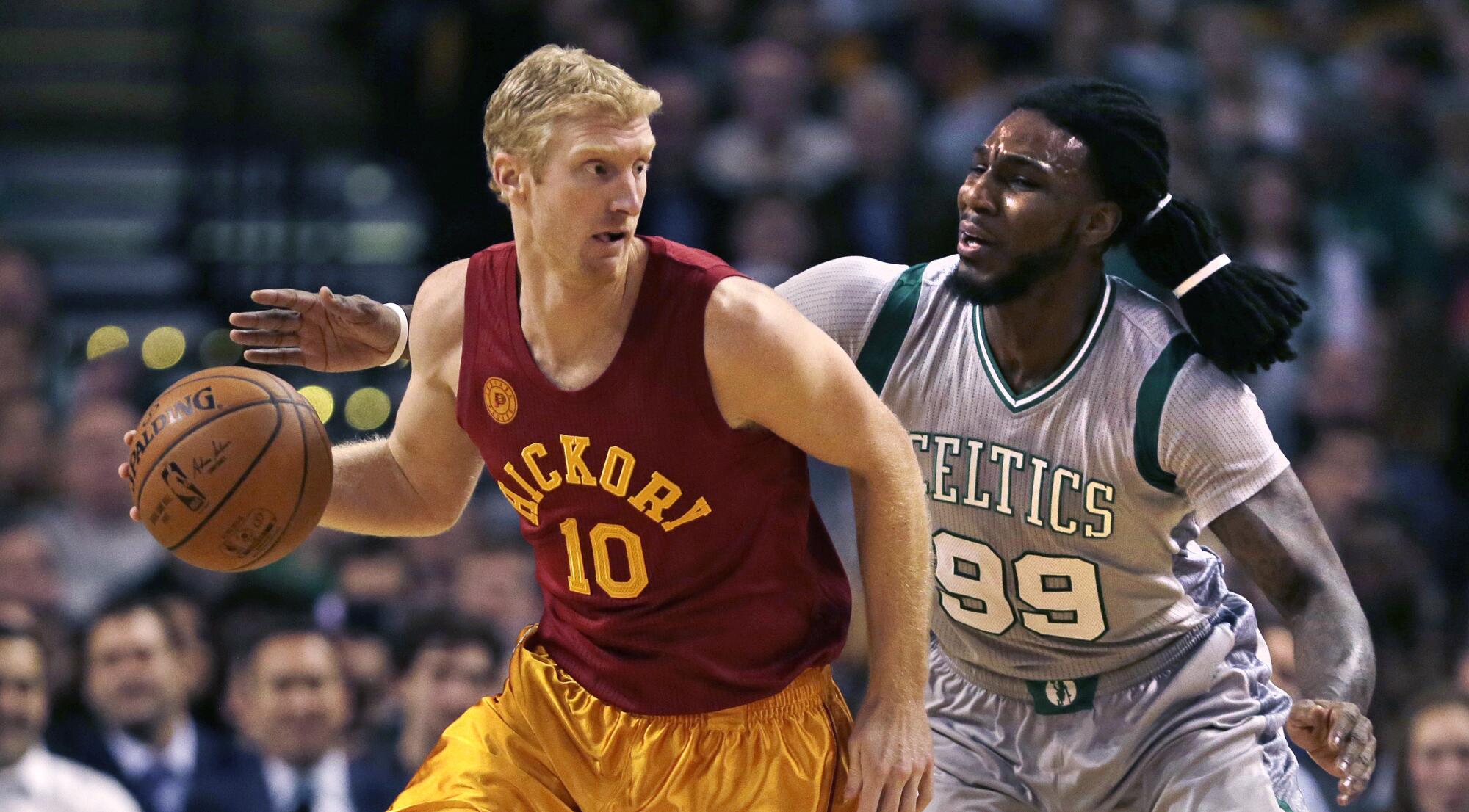
Indiana Pacers forward Chase Budinger, left, controls the ball in front of Boston Celtics forward Jae Crowder during a game in January 2016.
(Charles Krupa / Associated Press)
The McDonald’s All-American became a star at Arizona, leaving after three seasons ranked 11th in career scoring. Drafted 44th overall by the Detroit Pistons, Budinger’s rights were traded immediately to the Houston Rockets, with whom he played three years and averaged 9.4 points and 3.4 rebounds. He played three more seasons with the Minnesota Timberwolves before splitting his last year in the NBA between Indiana and Phoenix.
But he was never far from beach volleyball during his basketball career. He played in volleyball events, often on four-man or six-man teams, counting former NBA player Richard Jefferson and former Lakers coach Luke Walton among his beach teammates. He bought a home in Hermosa Beach, the training mecca for many of the world’s top beach teams.
When two-time Olympian Sean Rosenthal gave Budinger the initial call that helped solidify his decision to pass on overseas basketball opportunities to start his beach volleyball career in earnest, Budinger’s volleyball skills were still raw. But the explosive blocker and attacker made the transition look easy alongside two of the sport’s iconic defenders. Budinger was named 2018 AVP rookie of the year with Rosenthal, then won his first AVP tournament in 2019 with Casey Patterson, his partner of two seasons. Armed with the same relentless mindset that helped him stick in the NBA, Budinger credited Rosenthal and Patterson with teaching him the nuances of his second sport.
“I really just try to bring my work ethic that I had in basketball to beach volleyball,” Budinger said. “Just trying to be the hardest worker … and really just work on the little things each and every day.”
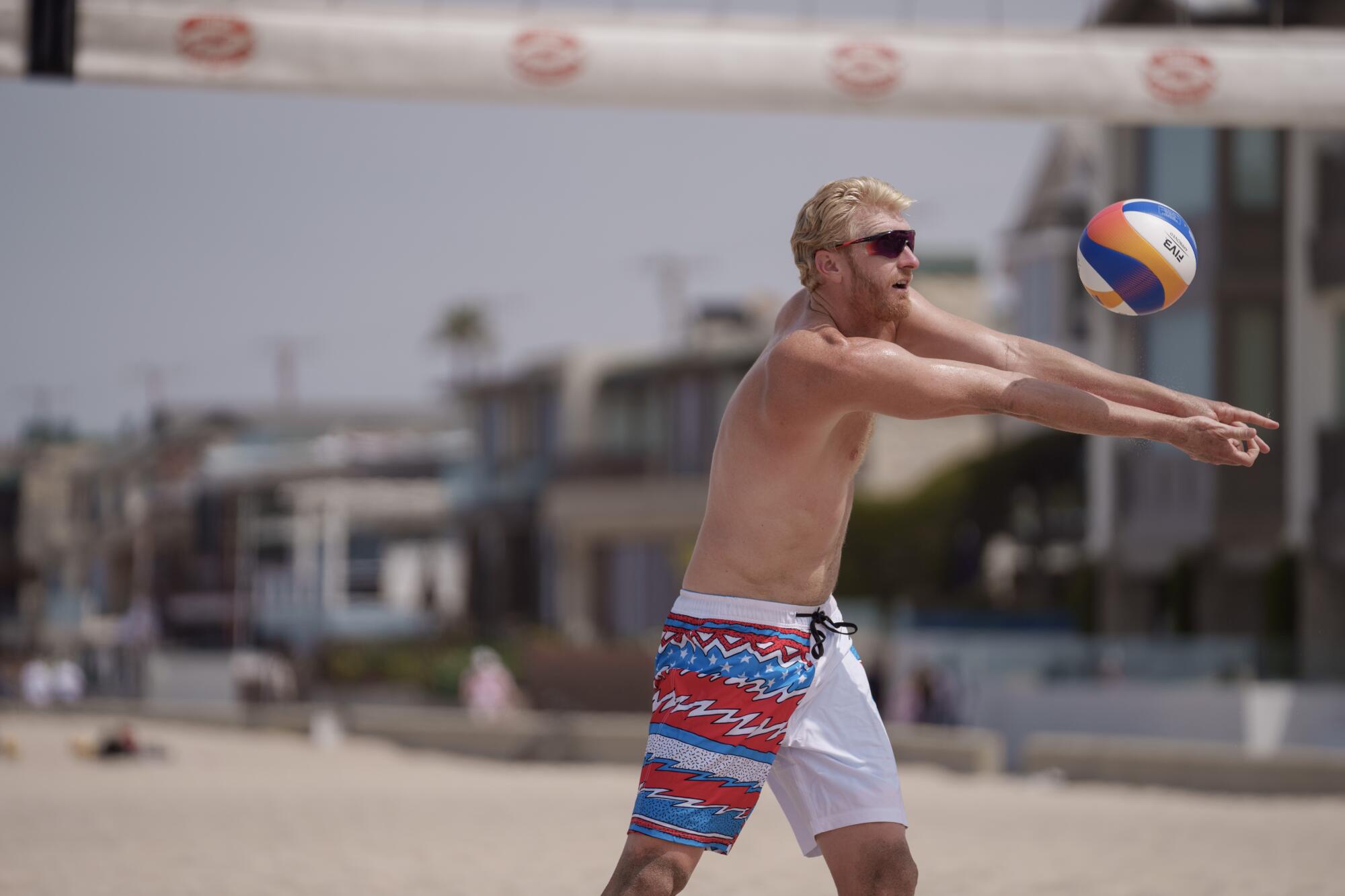
Chase Budinger takes part in a training session in Hermosa Beach. When Budinger decided to focus on volleyball after his basketball career, qualifying for the Olympics was one of his goals.
(Eric Thayer / For The Times)
The Olympics were an immediate goal when Budinger returned to volleyball. The qualifying window for Paris opened on Jan. 1, 2023, and Budinger set up interviews with several defenders who he believed could be a good fit.
Evans didn’t think he would even make the short list.
The Santa Barbara native didn’t believe he had proven himself domestically to get a look from Budinger. He has just one AVP event title, which he claimed in 2022 with Andy Benesh. He was shocked when he received a text from Budinger inviting him to meet for coffee. They talked about the goal of the Olympics and how they would train to reach it. Individually and as a team, Budinger said, they were not good enough.
Yet.
The pair practices five days a week. During the high-intensity sessions, they jump over knee-high ropes on the sand to simulate taking off for an attack and dive for balls in every corner of the court. Budinger refuses to let a set end on a bad rep.
“We really had that thought process in our minds to get better and we really did over the two years,” Budinger said. “We freaking just put our heads down. We grinded.”

For Miles Evans, left, and Chase Budinger, qualifying for the Paris Olympics was no easy feat.
(Eric Thayer / For The Times)
Budinger and Evans outlasted Trevor Crabb and Theo Brunner to earn their Olympic nomination in a nearly two-year qualifying process that came down to the final two months. To qualify for the Games, teams have to finish in the top 17 in the FIVB point standings and be among the top two pairs from their country. Budinger and Evans took until the fourth-to-last event to get into qualifying position, but charged to the finish with five consecutive top-five finishes. On a hot streak, the team’s confidence is at an all-time high, Evans said.
The pair has dialed in its system to a tee, Budinger said. Their personalities balance each other out. Budinger admits he can get hard-headed. Evans has the cool head to respond in a productive way, but they keep each other accountable without taking anything personally.
“Honestly, he’s one of the most professional players I’ve ever played with,” Evans said. “The way he goes about the sport is just so much more positive and so much more professional than most of the other guys.”
After chasing Crabb and Brunner for the majority of the qualification process, Budinger and Evans clinched their spot during the final tournament, where Crabb and Brunner failed to advance out of the preliminary bracket.

Beach volleyball players Miles Evans, left, and Chase Budinger will open group play in the Paris Olympics on Monday.
(Eric Thayer / For The Times)
From the tournament in the Czech Republic, Budinger and coach Ed Keller hunched over a phone to watch the match. Evans stood several feet away, unable to watch. He celebrated only when Budinger and Keller each raised two fists in the air after the final point.
Budinger was relieved. The process had been stressful. Traveling to small tournaments in far-flung international locations was grueling. With each country only allowed two spots, having to root against a fellow American duo felt like a sick mind game.
Budinger returned home after earning the Olympic bid to a street lined with red, white and blue banners. His neighbors decorated their homes with “Budinger-Evans 2024 Paris” signs. His wife, Jessica, taught the couple’s 2-year-old son, Beckham, to say a special phrase for the occasion.
“Dada’s going to the Olympics.”
Sports
How cricket became the next big thing for sport's wealthiest investors

Chuck Ramkissoon, the most interesting character in Joseph O’Neill’s award-winning novel Netherland, is a Trinidadian wheeler-dealer who has come to New York to make his fortune.
So far, so normal, but it is how he intends to make his mark that sets him apart from the thousands of other characters in stories about the American Dream because Ramkissoon’s route to riches is cricket.
In a memorable section of a remarkable book, Ramkissoon tells his friend, the story’s narrator, that he wants to build a cricket “arena” in Brooklyn.
Sensing his friend’s incredulity, our hero launches into a sales pitch that starts with the huge South Asian population in New York, moves into a business plan that involves 8,000 fans paying $50 (£39) each to watch 12 exhibition matches every summer, and ends with the kicker, “global TV rights… a game between India and Pakistan… a TV and internet viewership of 70 million in India alone… we’d breakeven in three, at most four years”.
This vision is meant to sound unrealistic, bordering on absurd. Cricket in New York? Attracting paying customers? With tens of millions watching on the other side of the world?
The book was written in 2008 but is set a few years earlier, more than two decades before 34,000 people watched India play Pakistan in the T20 World Cup in New York last month, a game that proved the old adage about truth being stranger than fiction.
The top hospitality tickets at the Nassau County Stadium had a face value of $10,000 (£7,800) and ordinary tickets were changing hands for more than $1,000 on the secondary market. The game garnered 256 million hours of viewing in India, an incredible figure for a contest that finished in the small hours of the morning there.
India fans in New York watch their team’s victory in the T20 World Cup final in June (Derek French/SOPA Images/LightRocket via Getty Images)
I was reminded of Ramkissoon last week when the England and Wales Cricket Board (ECB) revealed it has sent presentations to several owners of National Football League (NFL) teams to alert them to the opportunity of buying stakes in the eight teams that play in The Hundred, one of 17 different “franchise leagues” that have popped up in recent years.
Those pitch decks, which include a video explaining The Hundred’s rules, have also been sent to the owners of teams in the Indian Premier League (IPL), the daddy of those franchise leagues, and pretty much every serious multi-sport investor on the planet.
All have been invited to games in the month-long competition, which started on Tuesday, and various media outlets have reported that high-profile owners of British football teams, such as Wrexham’s Hollywood duo Rob McElhenney and Ryan Reynolds, are interested.
“Many of them know cricket very well, know The Hundred very well and may not feel the need to come,” explained the ECB’s director of business operations Vikram Banerjee during a conference call with reporters.
“Others, some of our American friends, for example, may like the idea of what we’ve got but don’t really know cricket at all, so they’ll come along and see what English cricket’s about.”
It is a lovely idea, expressed in quintessentially English fashion, but what the ECB is really selling is something far bigger than English cricket’s latest wheeze for remaining relevant — and solvent — in a fast-changing landscape. It is selling what Ramkissoon was selling: potential.
“Cricket is perhaps the only sport that has a combination of being the most popular game in a market as big as India but is also growing fast in so many new markets, such as the United States,” says Mike Fordham, a former ECB strategist who went on to become chief executive of the IPL’s Rajasthan Royals and now advises governing bodies from the Gulf to the Caribbean on running cricket leagues.
“And if you add the fact it has been added to the Olympic programme for 2028 in Los Angeles, and there is a good chance the 2036 Games will be in India, and look at how fast the women’s game is growing, the sport’s potential is obvious.”
So, after that long preamble, let us explore how cricket became just the ticket for every serious multi-sport investor, how American cricket fits in, and where the sport is heading.
But first, how big is the Indian cricket market?
According to the United Nations, India’s population, now north of 1.4 billion, overtook China’s about a year ago. This means one in six people alive are in India.
There are also millions of Indians living in other countries, including more than four-and-a-half million in the U.S. and more than a million in the UK.
India’s gross domestic product has been rising fast for the past 20 years and its economy is now either the third, fourth or fifth largest on the planet, depending on which metric you prefer. India still has hundreds of millions of very poor people, but the proportion in poverty is falling as its well-educated, urban middle class grows.
Cricket is India’s most popular sport and it is not even close.
It is the same story elsewhere in South Asia. Add the populations of Afghanistan, Bangladesh, Nepal, Pakistan and Sri Lanka to India’s and you clear the two-billion mark, which means one in four people live in countries where cricket is the number one sport, which does not include the sport’s fans in Australia, England, Jamaica, South Africa and everywhere else the game is loved.

Indian Premier League games are regularly played in front of packed stadiums (R Satish Babu/AFP via Getty Images)
“Obviously any conversation about cricket’s appeal has to start with India, and as India has got bigger and richer, so has cricket,” explains Gareth Balch, chief executive of global sports agency Two Circles.
“There are so many different numbers you can pluck out, from the rising value of IPL franchises to how many people consumed the broadcast of the India-Pakistan game in New York this summer.
“But a really good one is if you look at the total value of cricket’s media rights — it has risen fivefold over the past five years. That is remarkable growth and most of that is being driven by India and the rest of South Asia.”
As Balch notes, there are dozens of metrics you can choose to demonstrate the might of the Indian market, but let us pick out a few more to hammer this point home.
According to Oakwell Sports Advisory, a London-based firm, “India constitutes 90 per cent of the one billion cricket fans aged 16 to 69 globally” and “the Indian market is more than twice as large as the other 11 ICC (International Cricket Council) full member countries (the game’s most established nations) combined”.
When India played Pakistan at the 2019 Cricket World Cup in England, 800,000 fans applied for tickets and the game was watched by 229 million viewers on Star Sports, Disney’s Indian pay-TV network. India’s semi-final against New Zealand in that tournament drew an online audience of more than 25 million, a world record for concurrent live streams. That record has since been stretched to 35 million for another World Cup game between India and Pakistan last year.
When the IPL’s first eight franchises were sold in 2008, they went for more than $700m, almost double the reserve price. But when two expansion franchises were sold in 2021, they went for more than $1.2billion. Oakwell estimates the IPL’s total enterprise value to be over $15bn. Not bad for 10 teams that only play for two months a year.
These franchises are owned by the richest families and biggest conglomerates in India — the Ambani family, who recently threw a $600m wedding, co-own five-time IPL champions the Mumbai Indians — and the league officially became a “decacorn”, a start-up business that grows to a valuation beyond $10bn, in 2022.
Last year, the IPL sold its domestic media rights to Star Sports and Viacom18 in a five-year deal worth $6.2bn, three times the amount achieved in 2017. The deal means IPL games are second only to the NFL in terms of revenue per match, knocking Premier League fixtures into third place.
You get the picture.
OK, tell me more about The Hundred
Launched in 2021, it is a competition — with men’s and women’s versions — played between eight city-based franchises in England and Wales.
Its unique selling point is that it is even quicker than the Twenty20 (T20) format that has become the most popular version of the sport almost everywhere. The most notable exception to this is England, where Test cricket, which is played between international teams over five days, subsidises everything else, including the grassroots game.
Unfortunately, only cricket fans in Australia and India appear to like Test cricket as much — or in sufficient numbers — as English fans, which is why cricket chiefs have been looking for shorter versions of the game for more than 70 years.
The first was a format that could be played in a day. It is still catchily known as one-day cricket and involves each team getting 50 six-ball “overs” to score as many runs as possible. Every subsequent new format has just reduced the number of overs available, cutting the amount of time each game takes and encouraging players to score quickly.
Ironically, it was the ECB, in 2003, that came up with T20, which, you guessed it, is a 20-over-per-team game. For a time, its mix of big hits, quick wickets (or outs, in baseball parlance) and the excuse it provided for outdoor drinking on summer evenings reversed the gradual decline of the domestic game. But, like so many other English inventions, it was perfected elsewhere, particularly in India.
So, the ECB, knowing it has to diversify from Test cricket and ever conscious of the shadow thrown by football, had another go and came up with The Hundred, a format that is literally 100 balls per team, which knocks 40 balls and about half an hour off the duration of a typical T20 match.

The Hundred has proved popular with fans in the UK (Stu Forster/Getty Images)
This, it believed, would attract more families to the games and persuade free-to-air broadcasters, like the BBC, to find some space in their prime-time schedules. It also decided to give the women’s competition equal billing and prize money from the off, with most games staged as double-headers.
Guess what? It worked. Now in its fourth season, The Hundred has been a domestic hit. Thanks to relatively low ticket prices and a big marketing push, attendances have been younger and more diverse than typical cricket crowds. The audiences on the BBC and Sky, the competition’s main broadcast partner and biggest benefactor, have been solid and the highlight reel-friendly action has done well on social media.
Contrary to some of the gloomier predictions that surrounded its birth, The Hundred has not killed off the older T20 league still played by the 18 counties that constitute English cricket’s traditional professional pyramid or ruined the competitive balance of the wider domestic game, in all its formats, by giving the counties that host Hundred franchises a massive leg-up. Not yet, anyway.
You can probably sense there is a “but” coming, can’t you?
Yes, what is it?
In short, The Hundred has not resonated beyond England’s shores.
This would not be such an existential threat if it were not for the fact that T20, powered by Indian money, has continued to spread its tentacles, grabbing chunks of the calendar — by far the most valuable real estate in any global sport — and increasing the cost of talent.
For the demographic reasons discussed above, the ECB never wanted to compete pound for rupee with the IPL when it came to attracting the best players, but it did think it could still beat nascent competitions in new territories such as Canada, the United Arab Emirates and U.S. for talent.
Seeing the top Australian players go from their Big Bash League, during the Northern Hemisphere’s winter, to million-dollar spells in the IPL and then lucrative stints in America’s Major Cricket League — which has attracted significant Indian investment — was one thing, but when players start pulling out of agreements to play in The Hundred because they can earn the same money in less time in Canada, the need for action is clear.
There is also pressure building within the English game, too, as those 18 counties, most of whom are member-owned, are groaning under almost £200m of debt. The Hundred was initially sold to them as a means to reset the clock.
The ECB rejected an offer of £300m for 75 per cent of the entire competition from British private equity firm Bridgepoint Group two years ago. Given the rising prices of IPL franchises and the sums being spent on teams elsewhere, that was probably a good call.
But there is a right time to cash in on every asset and now looks like that time for The Hundred.
The ECB, however, is not seeing it quite that simply. For the governing body, this sales process, which is for 49 per cent stakes in each franchise, is as much about making sure The Hundred is one of the franchise leagues still standing when the inevitable consolidation comes, as it is about finding a quick fix for the counties’ overdrafts.
So, unlike the auctions that have driven franchise values up in India, the ECB has asked both financial services giant Deloitte and Raine, the American boutique bank which has become sport’s go-to auctioneer, to run what Banerjee described as a “very strange speed-dating” process that will hopefully see The Hundred’s host venues partner up, “in a weird kind of school disco moment”, with an international investor.
On the same conference call, the ECB’s CEO Richard Gould stressed that this is as much about “skill sets” in areas such as digital engagement, event management and women’s sport as it is about massive cheques, although massive cheques would be nice, too.
If this sounds to you a bit like former British prime minister Boris Johnson’s policy on cake — “pro having it and pro eating it” — you are not the only one.
Banerjee and Gould were speaking only a few days after British newspaper The Telegraph reported unnamed IPL sources saying the ECB had no chance of raising the £200m or so it is aiming for from these sales of large minority stakes. They were actually a bit ruder than that, suggesting the process was a “car crash” and the suggested valuations “delusional”.
When asked about this, Gould drily noted the ECB has spoken to every single owner of an IPL and WPL (Women’s Premier League) team and they all seemed pretty interested in The Hundred then, which might be why they are now trying “to negotiate through the media”.
This is a fair comment, but The Athletic has spoken to several sources — who asked to remain anonymous to protect relationships — who believe the financial return from all of the ECB’s matchmaking will be “underwhelming” unless some of the host venues sell some or all of the 51 per cent stakes they have been gifted.
In other words, 49 per cent stakes will not bring in those massive cheques, particularly from IPL owners who have snapped up franchises in South Africa, the U.S. and elsewhere, but 70 per cent or even 100 per cent stakes might.
“No investor will want a minority stake and just see their funds go into infrastructure and other assets related to the county game that they have zero control over,” explains Oakwell’s Andrew Umbers.
“Therefore, the valuations are all over the place. Currently, nobody is selling a majority, but that might change.”
Fordham agrees.
“The real appeal for IPL investors would be in creating a bigger platform for sponsors, multi-league annual contracts for players and coaches, and more control of the calendar,” he says.
“I actually think most of The Hundred franchises will end up with IPL investors and at least a couple of them will be wholly owned by IPL groups.”
Laurie Pinto is a British financier who has been helping wealthy people buy and sell sports teams for years. He sees it like this.
“The ECB knows it has to do something and in cricket, that usually means cosying up to India and there will definitely be some of that,” he explains.
“But they are also worried about the ‘India-fication’ of cricket, for want of a better term. They are worried about India’s economic dominance of the game. That is why they brought in Raine. They want to globalise their ownership structure.
“The dream would be to link Wrexham with (Cardiff-based Hundred franchise) the Welsh Fire, or (NFL legend) Tom Brady’s crowd at Birmingham City with the Birmingham Phoenix. They’ll be talking to everyone: Fenway Sports Group, the Kroenkes, the Glazers, Jim Ratcliffe, all of them.”
It is not an unrealistic dream, either. Avram Glazer, admittedly not the most popular sports team owner in the UK throughout his time at Manchester United, was outbid for those two IPL expansion franchises three years ago but paid $30m for the Desert Vipers in the UAE-based International League T20 competition.
It has also been reported that Austrian drinks giant and multi-sports team owner Red Bull might want a slice of The Hundred. Red Bull already sponsors several Indian cricketers and has just hooked up with Leeds United. Yes, Leeds United, the Championship football team co-owned by Paraag Marathe, the former chairman of USA Cricket.
And just to really confuse you, RedBird Capital, the New York-based investment firm that owns AC Milan and Toulouse, as well as having a stake in the Fenway Sports Group empire, bought 15 per cent of the IPL’s Rajasthan Royals in 2021.
So America’s main contribution here is money?
Yes and no. English cricket would love American money. Please send some as soon as possible.
But cricket more generally wants American attention, love, respect… and money. Some of that has already started to flow.
As already mentioned, the 2024 T20 World Cup was co-hosted by Cricket West Indies, the governing body for the game in the Caribbean, and USA Cricket, with 16 of the 55 games taking place in the U.S.
Those games were shared between venues in Florida, New York and Texas, and, while there was some grumbling about the quality of the playing surfaces (another link with O’Neill’s Netherland), the tournament could not have gone much better for American cricket, with the U.S. claiming the upset of the tournament, a win over Pakistan, and reaching the second round.
That victory over Pakistan, and the earlier one against Canada, happened at Grand Prairie Stadium, near Dallas, which is the closest thing the U.S. has to Ramkissoon’s “Bald Eagle Field” and one of the two venues used by Major League Cricket (MLC), the six-team franchise league that is just about to complete its second season.
Launched in 2023, it is owned by American Cricket Enterprises, a consortium of private investors, including some of the franchise owners, which is comprised of IPL team owners and successful Indian-Americans, such as Microsoft chief executive Satya Nadella.
Their combined financial firepower has enabled the MLC teams to attract the current and former Australia captains, Pat Cummins and Steve Smith, as well as their Australian team-mates Travis Head and Glenn Maxwell, former South Africa skippers Quinton de Kock and Faf du Plessis, and ex-West Indies captain Kieron Pollard, as well as several other leading internationals. In terms of global stars, the MLC has trumped The Hundred by paying them more than the £125,000 maximum on offer in England this month.
English cricket bosses will be relatively relaxed about missing out on a few big names, particularly if it serves the greater purpose of growing cricket, especially in a new market that might, one day, provide some balance to India’s outsized influence over the game.
The T20 World Cup was one step on that journey, the MLC is another, and the first Olympic T20 competition at the Los Angeles Olympics in four years will be another.
“Cricket is full of opportunity — it’ll be one of the fastest-growing sports economically in the next decades,” says Balch.
“With this opportunity come choices: one choice would be for the cricket economy to resemble basketball’s, with the IPL potentially being the NBA. Basketball is a truly global sport with a dominant league. The U.S. ‘Dream Team’ might not win every game it plays, but every other basketball league on the planet is a few steps below the NBA.
“Cricket has to choose whether that’s the best economy for the game, especially considering the multiple formats of the game.”
Deciding whether your sport should have a league as dominant and successful as the NBA or not is a nice choice to have, though.
Ramkissoon would have loved such options. When he emailed potential backers with his great pitch for bringing back America’s “oldest team sport”, he received responses such as “Whoever, could you please stop sending me crazy junk mail?!”.
I should probably mention that the novel starts with the narrator being told that Ramkissoon’s “remains” have been found in a canal, in handcuffs, “evidently the victim of murder”.
He was a complicated man, though. Far more complicated than cricket, which is actually quite a simple bat-and-ball game. Far better than baseball. As hundreds of millions of Indians, Bangladeshis, Pakistanis, Afghans, Australians, New Zealanders, English, South Africans, Bajans, Jamaicans, Dutch, Irish… the list goes on, will tell you.
(Top photo: iStock; design: Eamonn Dalton)
-

 Midwest1 week ago
Midwest1 week agoMichigan rep posts video response to Stephen Colbert's joke about his RNC speech: 'Touché'
-

 News1 week ago
News1 week agoVideo: Young Republicans on Why Their Party Isn’t Reaching Gen Z (And What They Can Do About It)
-

 News1 week ago
News1 week agoRNC speakers want to separate the president from the person to show softer side of Trump
-

 News1 week ago
News1 week agoVideo: J.D. Vance Accepts Vice-Presidential Nomination
-

 Politics1 week ago
Politics1 week agoFox News Politics: The Call is Coming from Inside the House
-

 World1 week ago
World1 week agoCivilians try to pick up daily life in Ukraine's East
-

 World1 week ago
World1 week agoTrump to take RNC stage for first speech since assassination attempt
-
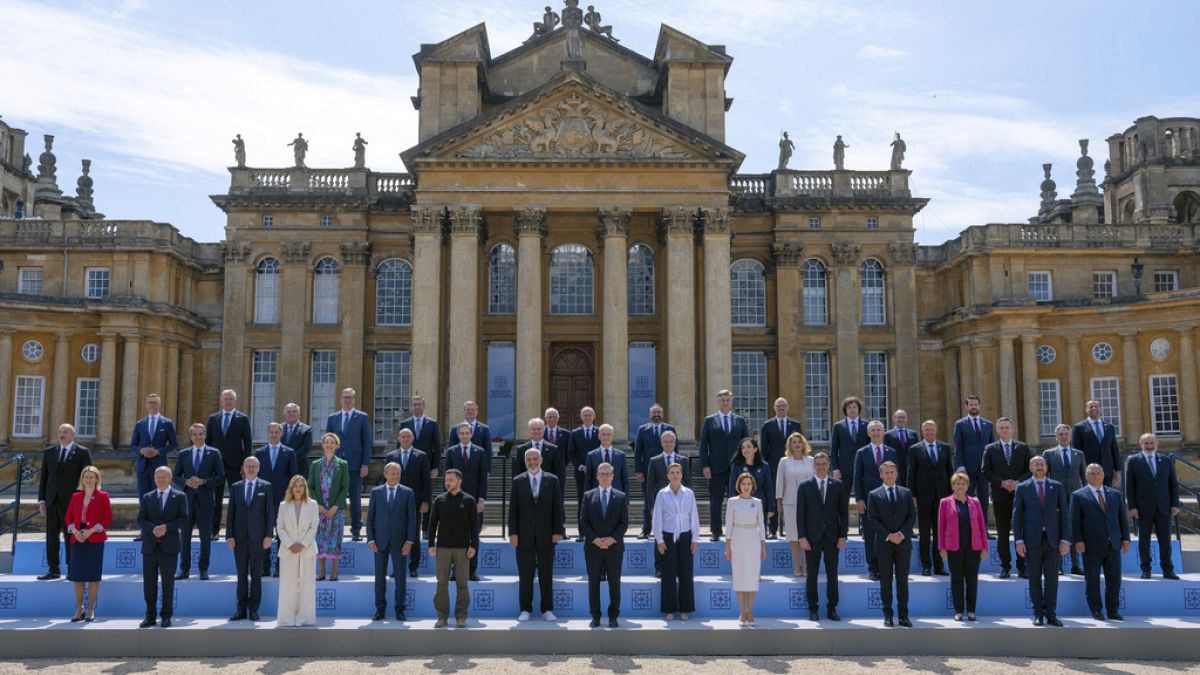
 World1 week ago
World1 week agoFrom Ukraine to EU-UK ties: Big summit of European leaders kicks off





